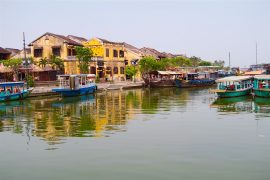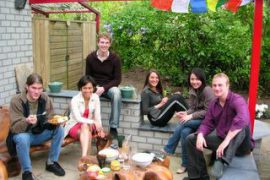Yangon, the city of Shwedagon Paya, as Lonely Planet called it.
It is so true. Visitors who come to Yangon would not miss the chance to visit one of the world’s most impressive Buddhist temples: Shwedagon Paya (Paya means Pagoda). It was actually my first reason why I decided to go to Myanmar. One day, I flipped through my friend’s photo album on the Internet and found a gorgeous picture of Shwedagon Paya. I was so impressed with its beauty and could not stop thinking about it ever since…
Shwedagon Paya’s dome is considered as the most sacred Buddhist site in Myanmar. It is made of gold and rises 322 feet above its base. Legend says that the stupa is 2,500 years old, but archeologists believe that it is built in between the 6th and 10th century. It is still old, anyway… and the fact that it is very well preserved and so beautiful really impressed me.
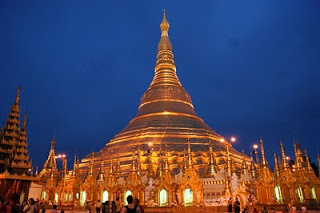 The locals believe that when one walks inside the Shwedagon Paya complex, one should walk clock wise. Otherwise, it will bring a bad luck. At first, I forgot this “rule” and I walked the other direction. People stared at me with a strange look and I was wondering why. Then, I realized that I’ve made a mistake! Ouch! Of course I didn’t want to get any bad luck! Soon after, I was circling the stupa in the “right” direction, hoping that the good spirit “forgot” that walked in the wrong direction before :p. Hehehe..
The locals believe that when one walks inside the Shwedagon Paya complex, one should walk clock wise. Otherwise, it will bring a bad luck. At first, I forgot this “rule” and I walked the other direction. People stared at me with a strange look and I was wondering why. Then, I realized that I’ve made a mistake! Ouch! Of course I didn’t want to get any bad luck! Soon after, I was circling the stupa in the “right” direction, hoping that the good spirit “forgot” that walked in the wrong direction before :p. Hehehe..
One would need a couple of hours to marvel this stunning temple. Shwedagon Paya is not only big in terms of size, but also very elegant and pretty. The stupa itself is decorated with all kinds of jewels and gems. What a beauty! Around the main stupa, there are many Buddha statues and halls for praying. It is hard to not fall in love with the place. I even visited this place twice during my trip in Myanmar!
What also makes this pagoda beautiful is the fact that the locals still come from miles away to pray here. This pagoda attracts not only tourists, but also the locals. They come here to pray, some of them come here to meditate. The whole complex is always busy, yet it is so clean and spotless! Unlike many other temples where the floors are dusty, Shwedagon Paya probably has the cleanest floor, considering the huge size of the whole complex. Again, this small thing impressed me. I must admit that whoever manages the temple, really pay attention to the details 🙂
Like it or not, foreign visitors who wish to marvel the beauty of the Shwedagon Paya has to pay USD 5,- for entrance fee and another USD 5,- if one brings a professional camera (SLR). It is free of charge for the locals. And, thanks to my Asian look, I managed to get in free since the staff thought that I was Burmese! Yeah!!! If the money goes for the temple’s maintenance, I would not mind paying – of course, but according to my guide book, all the tourists’ entrance fees in the whole country will go straight to the military generals’ or government officials’ pockets. And, as a responsible traveler, of course I did not want to support such system! So, I was so happy that I managed to fool the government officials during my visit to Shwedagon Paya… twice! Ha!
If one does not want to pay entrance fee but still wish to visit beautiful Buddhist temple in Yangon, he/she can visit Sule Paya. The temple is located in the heart of the city, thus, after visiting the temple, one can start exploring the surrounding areas by foot. When I was in Sule Paya together with a German girl whom I accidentally met, two Buddhist monks approached me and said something in Burmese, which I didn’t understand at all. They were surprised when I told them that I was from Indonesia :). They have never met an Indonesian before… One of them asked me, “Do you want to be our friends?” Oooww… how sweet!
Apparently, they confessed that they’ve followed me since they saw me walking down the street. I was surprised. “Why did you follow me?”, I asked. They said, “Because we want to practice our English and you seemed like a friendly person. We thought you’re a tour guide of this German girl”. Hahaha!
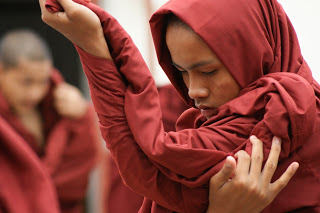 So, I ended up spending the rest of the afternoon (of my first day in Yangon!) chatting with a German girl and two young Buddhist monks! We sat on a damp wooden chair, under a tree in a beautiful garden not far from Sule Paya. Win Win, a 175 cm tall with 2 silver teeth shining every time he smiled, spoke with broken English. Sondra, 28 years old, very skinny and tiny, spoke better English than his pal. We chatted about everything… from family, culture, monk’s life, rituals, and hobbies.
So, I ended up spending the rest of the afternoon (of my first day in Yangon!) chatting with a German girl and two young Buddhist monks! We sat on a damp wooden chair, under a tree in a beautiful garden not far from Sule Paya. Win Win, a 175 cm tall with 2 silver teeth shining every time he smiled, spoke with broken English. Sondra, 28 years old, very skinny and tiny, spoke better English than his pal. We chatted about everything… from family, culture, monk’s life, rituals, and hobbies.
“Why did you decide to be a Buddhist monk?”, I asked Sondra
“Because of my Mom”, he said. He explained to me that one day, his Mom said, “If you want to make me happy, you should become a Buddhist monk. Monks life is good for you. A normal human life is not good for you. It is a hard life because you have to worry about money all the time, work very hard to live. You won’t be happy”.
Little Sondra wanted to make his mother happy, so he followed his mom’s advice by devoting his life for Buddha and live in a Buddhist monastery ever since.
“If your Mom didn’t ask you to become a monk, what would you actually want to be?”, I asked.
Wow. This conversation made me think of how big his love to his mother is. He’s made his life decision based on his mother’s request. He didn’t even have his own will. Or maybe I should put it this way: his mother’s will has become his will?
The monks took us sightseeing and said goodbye just before the sunset. Yangon city could be as dark as an underwater tunnel at night, especially when the government decided to turn off the power in the whole city… Shops and food vendors closed at 7pm, I didn’t even know where to go for drinks in the evening. Local bars were full of men. Seriously. There was no a single woman in the bars. I wasn’t sure whether it was because of the World Cup or women didn’t go out at night.
And walking in the darkness, Sondra’s voice echoed in my ears, “I want to live as a Buddhist monk for the rest of my life…”
…
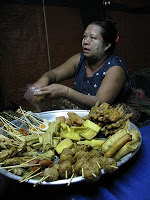 I felt very safe strolling down the streets of Yangon by myself. People were so nice and never disturbed me. There were a lot of Indians, who have sharp and scary looks but appeared to be very friendly and sweet, selling some snacks in the food vendors on the streets. You would not have to worry of feeling starving here. There were plenty of snacks to nibble in every corner of the city! Spring rolls, samosa, fried vegetables (tempura-like, but without the soya sauce, we call it “gorengan” in Indonesia) were some of the locals’ favorite snacks. Someone had warned me that the Burmese food was oily. But being an Indonesian, I was so used to oily food. In fact, I loved it! 😀
I felt very safe strolling down the streets of Yangon by myself. People were so nice and never disturbed me. There were a lot of Indians, who have sharp and scary looks but appeared to be very friendly and sweet, selling some snacks in the food vendors on the streets. You would not have to worry of feeling starving here. There were plenty of snacks to nibble in every corner of the city! Spring rolls, samosa, fried vegetables (tempura-like, but without the soya sauce, we call it “gorengan” in Indonesia) were some of the locals’ favorite snacks. Someone had warned me that the Burmese food was oily. But being an Indonesian, I was so used to oily food. In fact, I loved it! 😀
One day, I visited Chaukhtatgyi Paya, a home to one of Myanmar’s most beautiful reclining Buddhas. The huge reclining Buddha smiled peacefully. Despite the impressive size of the Buddha, not many people visited this temple, surprisingly. The complex was not packed, there were only a few people sitting down in front of the humongous Buddha statue, praying and meditating… Some women fell asleep in front of the Buddha statue. Perhaps they were taking a break in between their meditation.. 🙂
The compound was very peaceful and quiet. There were a number of monasteries, housed for around 300 monks. I got a privilege to visit some of the monasteries in the area of Chaukhtagyi Paya and chatted with the monks there. Even though most of them didn’t speak English, the kept on talking to me in Burmese language, hoping that I would understand them, somehow.
 According to him, the government didn’t like it when monks spent time chatting with tourists. Perhaps the government worried if monks/locals shared stories on how bad they treated its people. I heard many tourists were followed by a spy. But during my stay there, I didn’t feel that anyone followed me. Apart from the two Buddhist monks I met in Sule Paya! 😀 Perhaps even the spy thought that I was Burmese. Hihihi…
According to him, the government didn’t like it when monks spent time chatting with tourists. Perhaps the government worried if monks/locals shared stories on how bad they treated its people. I heard many tourists were followed by a spy. But during my stay there, I didn’t feel that anyone followed me. Apart from the two Buddhist monks I met in Sule Paya! 😀 Perhaps even the spy thought that I was Burmese. Hihihi…
If you’re into shopping or want to buy some souvenirs, the perfect place to go is Bogyoke Aung San Market. This market has everything you need for souvenirs, from long-yi (Myanmar’s traditional sarong), scarf, bags, t-shirts, etc. The building is also clean and cool. I thought it has an AC to cool off the whole building, but apparently it hasn’t! Apart from the shops, it is actually a perfect place to escape from the Yangon’s heat.
Like in many other countries, Myanmar also has a Chinatown. A Chinese Buddhist temple stood elegantly by the street, with the rooftop decorated by dragons’ statues. It is also worth to visit this temple if you have enough time in Yangon. When I was there, some elderly Chinese locals gathered together in two different roundtables, right after the huge red entrance door. They all spoke in Burmese language 🙂
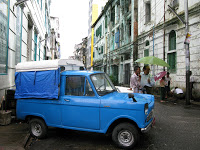 For those who love spending holidays in big cities, Yangon might not be the right place to go. Even though Yangon is considered as a big city in Myanmar, it is far from the image of big cities with skyscrapers, modern buildings, fancy restaurants, cinemas, and all those modernization thingy. Yangon is a very down-to-earth city, with old and cramped apartment buildings, food vendors scattered in each side of the main streets, and abandoned old colonial houses all around. The city is not pretty, but the streets are surprisingly clean. And don’t forget, the people are nice. Even when you’re in a shopping mood in the market, they won’t push you to buy their stuff. They will leave you alone, as if they don’t even care whether you will buy something from them or not! 😀 And oh, when we bargain for the price, they will only smile at you if your bid is too low and won’t even try harder to make you buy their stuff. Funny!
For those who love spending holidays in big cities, Yangon might not be the right place to go. Even though Yangon is considered as a big city in Myanmar, it is far from the image of big cities with skyscrapers, modern buildings, fancy restaurants, cinemas, and all those modernization thingy. Yangon is a very down-to-earth city, with old and cramped apartment buildings, food vendors scattered in each side of the main streets, and abandoned old colonial houses all around. The city is not pretty, but the streets are surprisingly clean. And don’t forget, the people are nice. Even when you’re in a shopping mood in the market, they won’t push you to buy their stuff. They will leave you alone, as if they don’t even care whether you will buy something from them or not! 😀 And oh, when we bargain for the price, they will only smile at you if your bid is too low and won’t even try harder to make you buy their stuff. Funny!
Getting around the city, one can hop on a “smurf” car (small pick-up car in blue), rickshaw, crap taxi (yes, the taxis are all crap and falling apart), and/or public bus (always packed and the drivers imposes crazy driving style!). I tried everything and my favorite was taking the rickshaw! Even though I felt bad for the rickshaw driver at times :(.
So many stories, so many impressions, so many temples. I’ll try to share a bit of my experiences with you in my other posts about Myanmar… the land of monks and gorgeous Buddhist temples…

